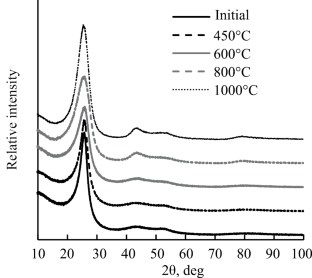Russian Journal of Applied Chemistry ( IF 0.9 ) Pub Date : 2024-04-23 , DOI: 10.1134/s1070427223080086 N. V. Egorova , R. R. Nasyrova , B. Yu. Mishinkin , Yu. S. Zimin , E. V. Kuz’mina , V. S. Kolosnitsyn

|
Abstract
Studies aimed at the development of cheap, safe, and effective carbon materials based on domestic resources for negative electrodes of lithium-ion and post-lithium-ion batteries are topical and have high practical significance. The paper summarizes the results of studying how the temperature of the heat treatment of petroleum coke in a nitrogen flow influences its physicochemical and electrochemical properties. Petroleum coke was kept for 5 h in a nitrogen flow at fixed temperatures of 450, 600, 800, 1000, and 1200°C. Heat treatment of petroleum coke leads to a significant decrease in the specific resistivity (from 4.8 × 107 to 1 × 10–2 Ω cm), to an increase in the specific surface area, and to a decrease in the pycnometric density (the temperature of 1200°C is an exception). Petroleum coke that has not been heat-treated or has been heat-treated at 450 °С exhibits no electrochemical activity. The carbon electrodes made of petroleum coke heat-treated at 600°C in a nitrogen atmosphere exhibit the maximal anodic capacity for lithium (340–350 mA h/g). However, carbon electrodes based on petroleum coke heat-treated at 600°С exhibit short cyclic duration and high irreversible capacity (58–60%). An increase in the petroleum coke heat treatment temperature to 1200°С leads to a decrease in the irreversible capacity to 40% and in the reversible anodic capacity to 220 mA h/g and to an increase in the cycling duration of the carbon electrodes. The petroleum coke heat-treated un a nitrogen atmosphere at 1000°C is the most promising material for negative electrodes of lithium-ion batteries from the viewpoint of the set of physicochemical and electrochemical properties.
中文翻译:

氮气气氛热处理温度对石油焦物理化学和电化学性能的影响
摘要
以国内资源为基础开发廉价、安全、有效的碳材料用于锂离子及后锂离子电池负极材料的研究具有很高的热点和现实意义。本文总结了石油焦在氮气流中热处理温度如何影响其物理化学和电化学性能的研究结果。将石油焦在450、600、800、1000和1200℃的固定温度下在氮气流中保持5小时。石油焦的热处理导致比电阻率显着降低(从 4.8 × 10 7到 1 × 10 –2 Ω cm),比表面积增加,比重密度(温度1200°C 是一个例外)。未经热处理或经过 450 °С 热处理的石油焦不表现出电化学活性。由石油焦制成的碳电极在氮气气氛中于 600°C 下热处理,表现出最大的锂阳极容量 (340–350 mA h/g)。然而,基于在 600°С 下热处理的石油焦的碳电极表现出短循环时间和高不可逆容量 (58–60%)。将石油焦热处理温度升高至 1200°С 导致不可逆容量降低至 40%,可逆阳极容量降低至 220 mA h/g,并导致碳电极的循环持续时间增加。从物理化学和电化学性能的角度来看,在氮气气氛中1000℃热处理的石油焦是最有前途的锂离子电池负极材料。



























 京公网安备 11010802027423号
京公网安备 11010802027423号